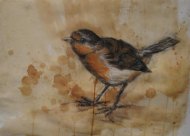Tags
À la claire fontaine, chanson en laisse, French-Canadian Folklore, Marc-Aurèle de Foy Suzor Coté, Songs of Voyageurs, The Nightingale, Theodore C. Blegen, Université de Moncton
 — Settlement on the Hillside, by Marc-Aurèle de Foy Suzor-Coté,* 1909 (National Gallery of Canada)
— Settlement on the Hillside, by Marc-Aurèle de Foy Suzor-Coté,* 1909 (National Gallery of Canada)
*Marc-Aurèle de Foy Suzor-Coté
Chanson en laisse
In a chanson en laisse, such as À la claire fontaine, the end of a couplet is the beginning of the next couplet. In poetry, the couplet is called a stanza (une strophe). Usually, the couplet consists of four lines (vers). À la claire fontaine also has a refrain. (See chanson en laisse, Wikipedia FR.)
If the Province of Quebec had an anthem, it could be À la claire fontaine. According to Wikipedia’s French-language entry on À la claire fontaine, the song dates back to the 18th century and it was the national anthem (un hymne national) of New France. If so, it is unlikely to date back to the 18th century. It would be an older song, as indicated in Wikipedia’s English-language entry on the same song. (See À la claire fontaine, Wikipedia.)
The canoemen (coureurs des bois or voyageurs) went up and down the St Lawrence River (the fountain) carrying fur pelts. Bathing in the St Lawrence River meant settling in New France. There were oak trees on both sides of le fleuve Saint-Laurent. After 1763, the year France ceded Nouvelle-France to England, the rose symbolized the English and the rosier (rosebush), England. Moreover, the you in il y a longtemps que je t‘aime (I have loved you for a long time) was France. (See À la claire fontaine, Wikipedia FR.)
À la claire fontaine was a favourite song among voyageurs, who were singers. This song has five hundred versions.
The Movie: The Painted Veil
A movie entitled The Painted Veil contains a lovely rendition of À la claire fontaine, so I have included the relevant video. The Painted Veil is a 2006 film adaptation of Somerset Maugham‘s The Painted Veil. Nostalgia is a feeling all human beings share.
About: À la claire fontaine
This song, a ballad, is about a young man who strolls by a clear fountain. The water (eau[f]) is so beautiful that he goes in to bathe (se baigner). He lets himself dry (sécher: dry up) under the leaves (feuilles[fp]) of an oak tree (chêne[m]). On the highest (la plus haute) branch, a nightingale (un rossignol [m]) sang. He tells the nightingale to sing (chanter) because he has a happy heart (tu as le cœur gai). You feel like laughing (rire), but I feel like crying (pleurer). I lost (J’ai perdu) my lady friend (ma maîtresse/mon ami/e) without deserving it (sans l’avoir mérité). Because I refused to give her (Je lui ai refusai) a bouquet of roses (la rose[f]). Would that the rose still be (fût) on the rosebush and the rosebush itself be (fût) thrown (jeter: to throw) into the sea (la mer). f: feminine, m: masculin, p: pluralEnglish Translation from The Painted Veil, 2006
Chorus: So long I’ve been loving you, I will never forget you. (incomplete)- At the clear fountain, While I was strolling by, I found the water so nice That I went in to bathe. Chorus
- Under an oak tree, I dried myself. On the highest branch, A nightingale was singing. Chorus
- Sing, nightingale, sing, Your heart is so happy. Your heart feels like laughing, Mine feels like weeping. Chorus
- I lost my beloved, Without deserving it, For a bunch of roses, That I denied her. Chorus
- I [would like] the rose To be still on the bush, And even the rosebush To be thrown in the sea. Chorus
À la claire fontaine
À la claire fontaine, M’en allant promener, (to stroll) J’ai trouvé l’eau si belle, (the water) Que je m’y suis baigné. Refrain Lui y a longtemps que je t’aime, (Il y a longtemps) Jamais je ne t’oublierai. (Never will I forget you) Sous les feuilles d’un chêne, (an oak tree) Je me suis fait sécher, (to dry) Sur la plus haute branche, Le rossignol chantait. (the nightingale) Refrain Sur la plus haute branche, (the highest) Le rossignol chantait, (sang) Chante, rossignol, chante, Toi qui as le cœur gai. (heart) Refrain Chante, rossignol, chante, Toi qui as le cœur gai, Tu as le cœur à rire, (to laugh) Moi, je l’ai à pleurer. (to cry) Refrain Tu as le cœur à rire, Moi, je l’ai à pleurer, J’ai perdu ma maîtresse/mon amie, (I lost my lady friend) (I lost my friend) Sans l’avoir mérité. (without deserving it) Refrain J’ai perdu ma maîtresse, Sans l’avoir mérité, Pour un bouquet de roses, Que je lui refusai. (I denied her) Refrain Je voudrais que la rose (I would like) Fût encore au rosier, (still)/* Et que le rosier même (the rosebush itself) À la mer fût jeté. (the sea) (to be thrown) Refrain The Painted Veil */Et que mon doux ami (And that my gentle friend) Fût encore à m’aimer. (Still loved me) ____________________ À la claire fontaine (from The Painted Veil.) Lang Lang (accompanist)

- The Painted Veil Poster, 2006 (Photo credit: Wikipedia)









